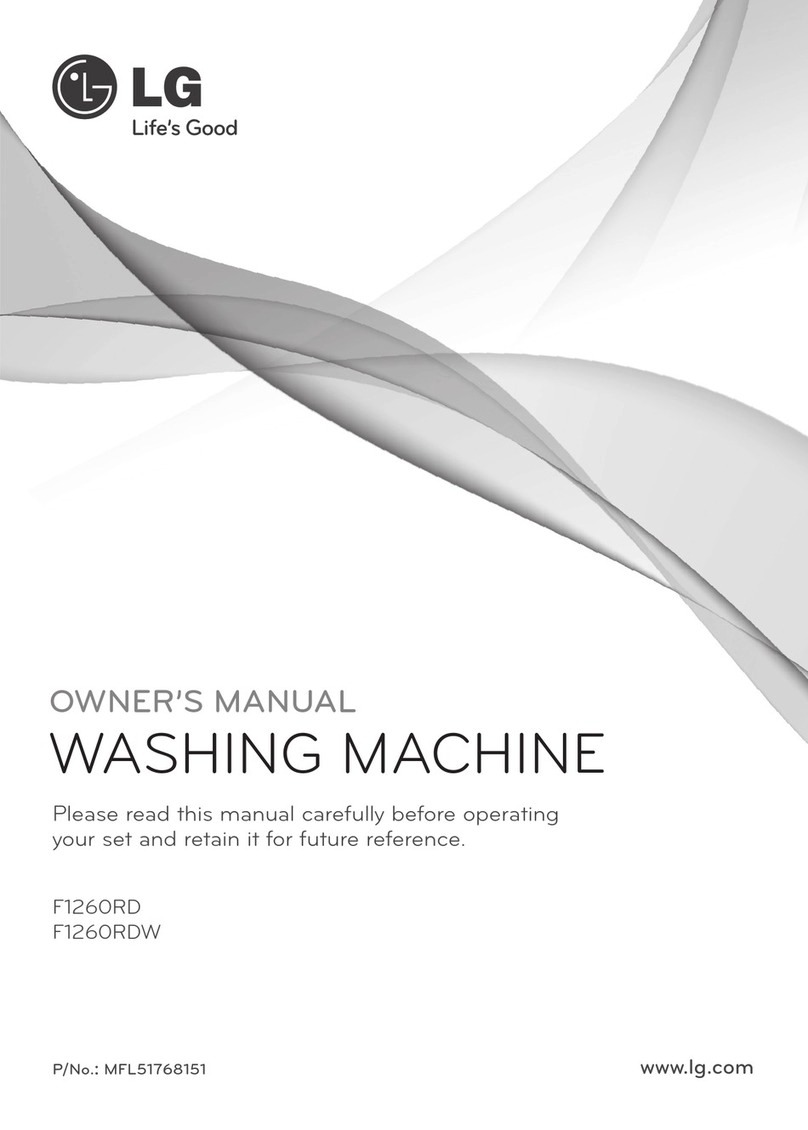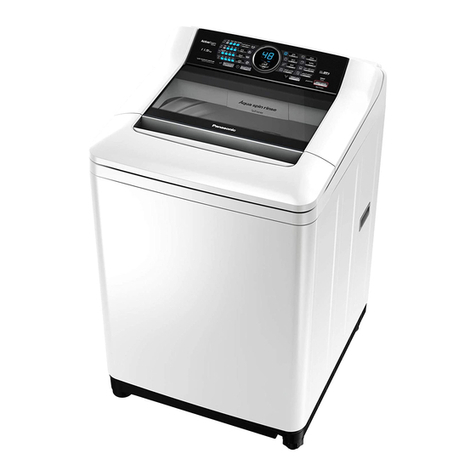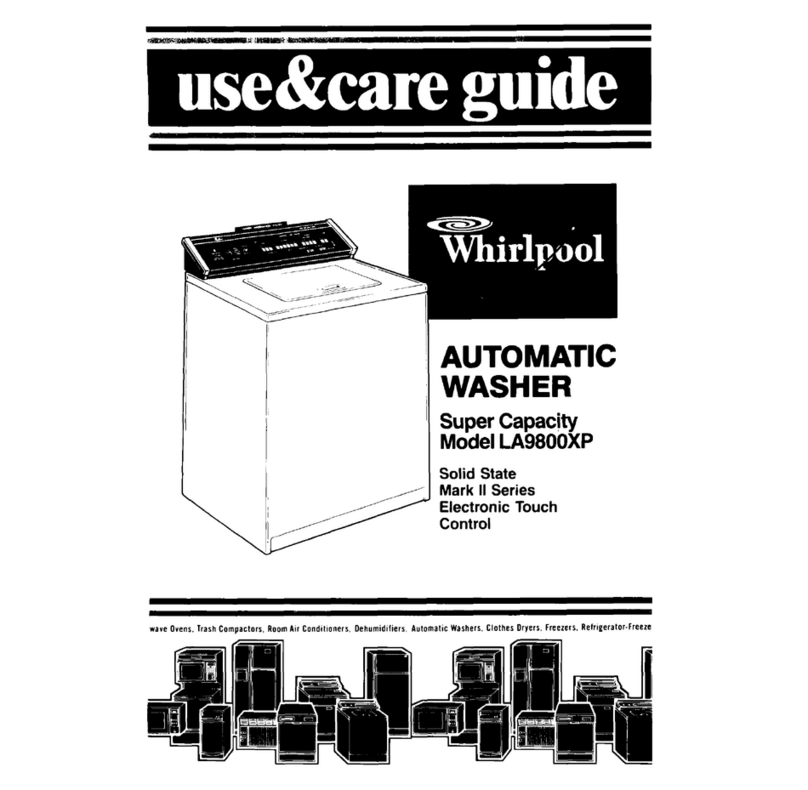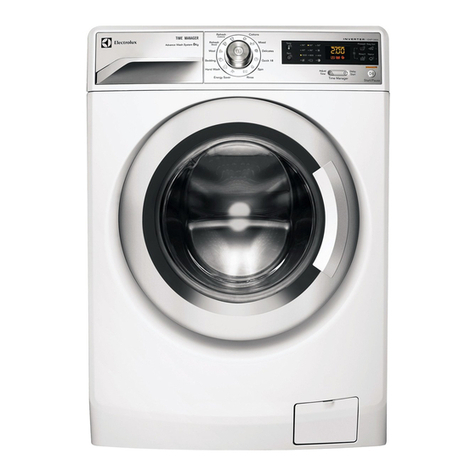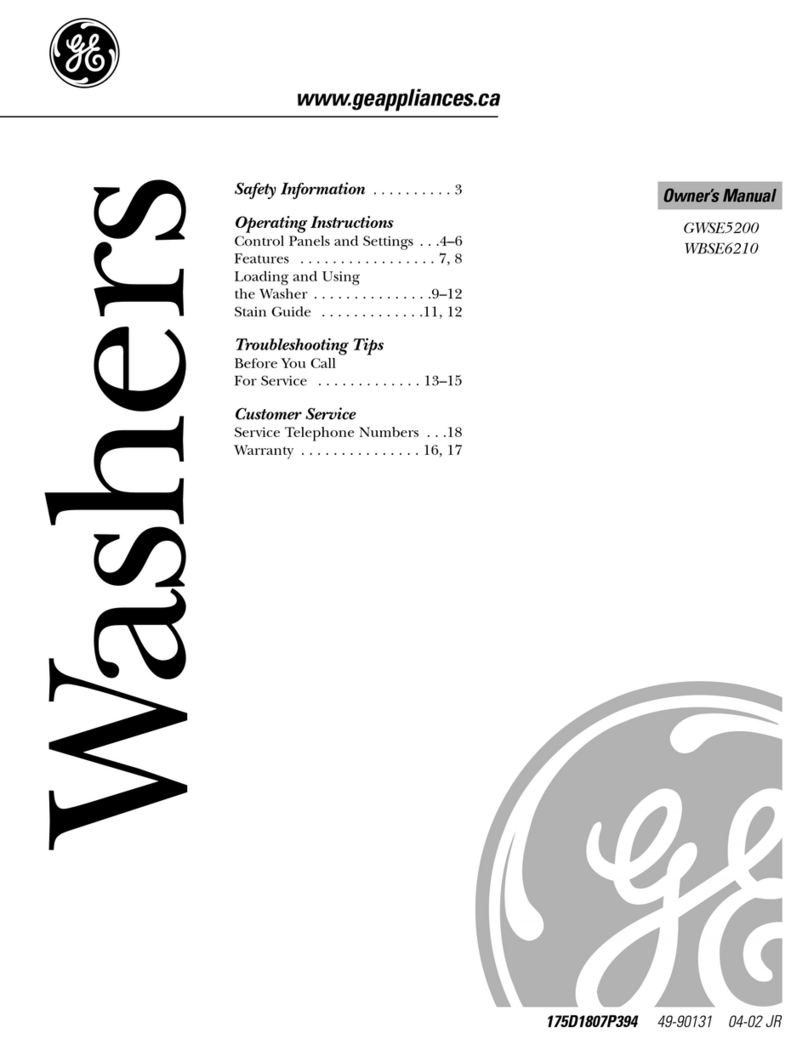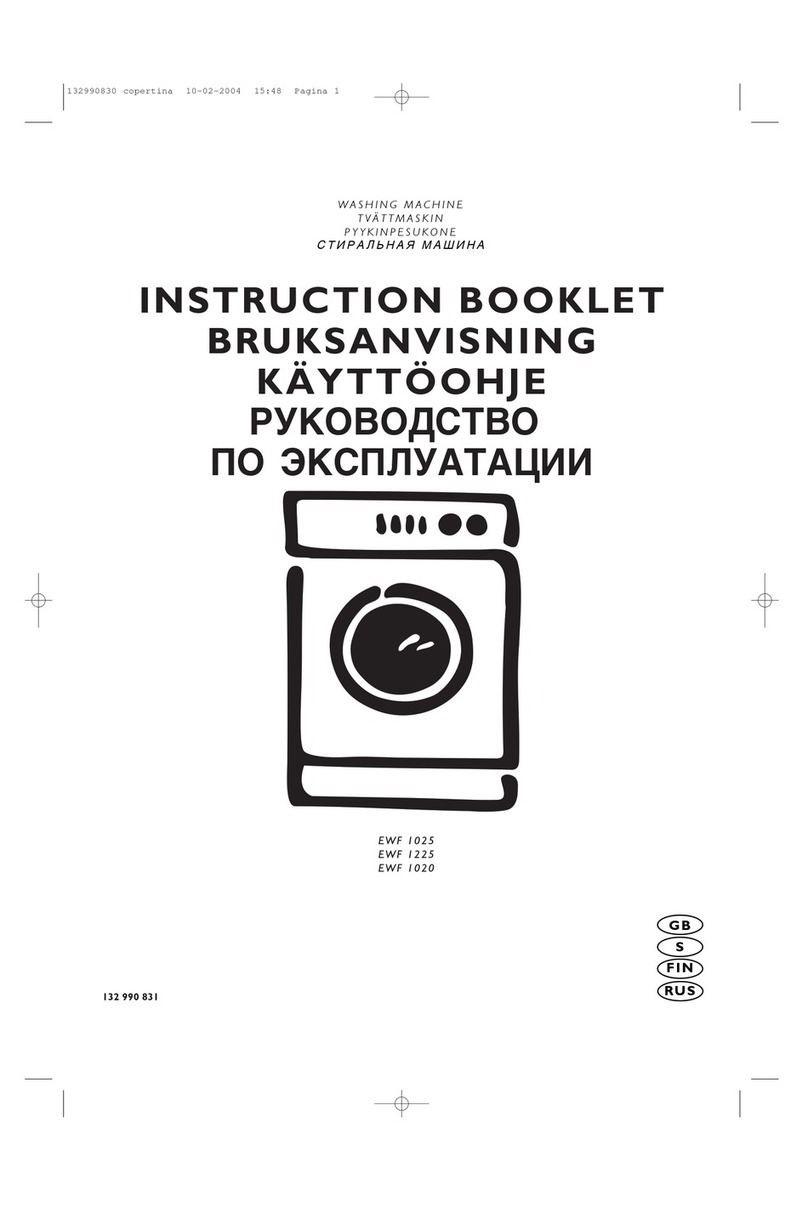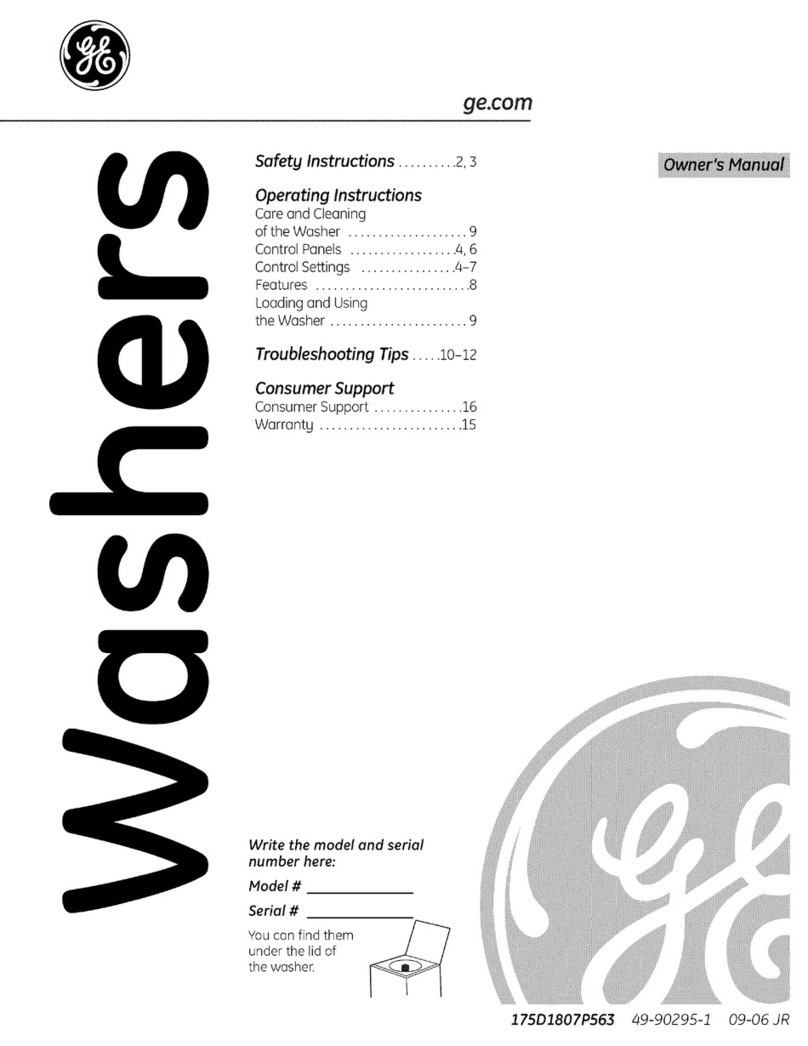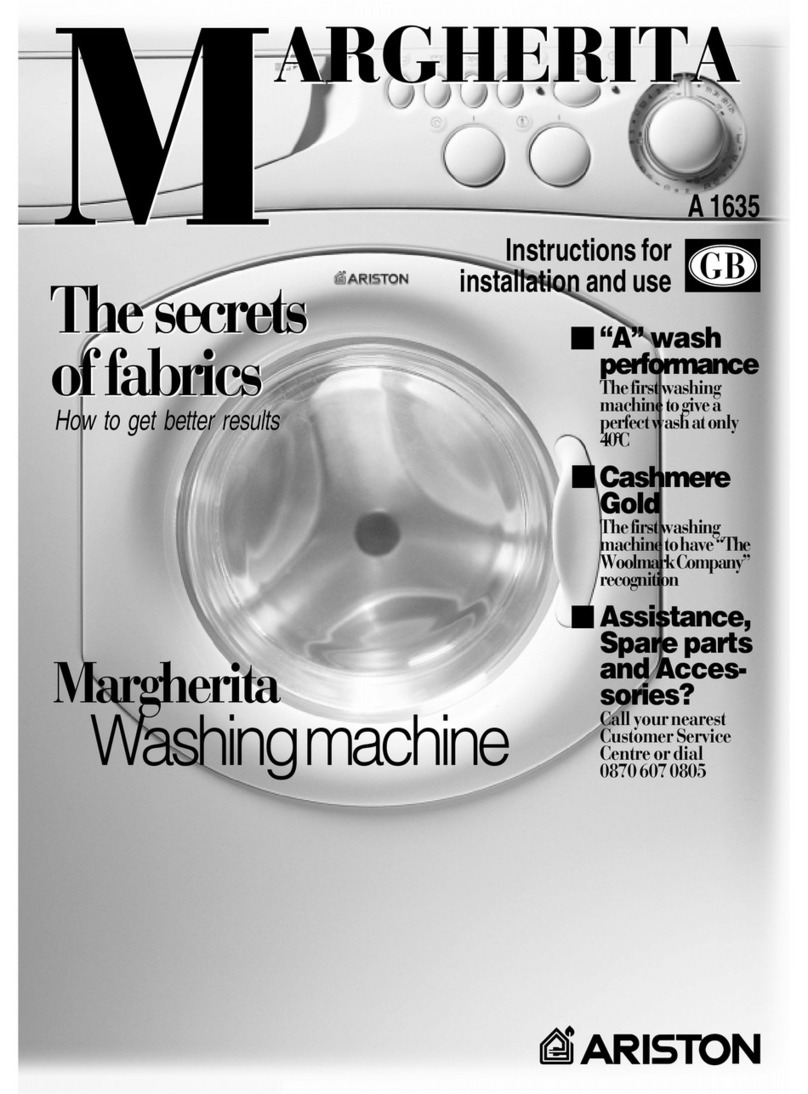Merloni WISE 107 X User manual

1
GB
English,1
Contents
Installation, 2-3
Unpacking and levelling, 2
Electric and water connections, 2-3
The first wash cycle, 3
Technical details, 3
Washing machine description, 4-5
Control panel, 4
Display, 5
MEMO Programme, 5
Starting and Programmes,
Briefly: how to start a programme, 6
Programme table, 6
Personalisations, 7
Setting the spin cycle, 7
Setting the Delay Timer, 7
Setting the temperature, 7
Functions, 7
Detergents and laundry, 8
Detergent dispenser, 8
Bleach cycle, 8
Preparing your laundry, 8
Special items, 8
Precautions and advice, 9
General safety, 9
Disposal, 9
Saving energy and respecting the environment, 9
Care and maintenance, 10
Cutting off the water or electricity supply, 10
Cleaning your appliance, 10
Cleaning the detergent dispenser, 10
Caring for your appliance door and drum, 10
Cleaning the pump, 10
Checking the water inlet hose, 10
Troubleshooting, 11
Service, 12
Before calling for Assistance, 12
WASHING MACHINE
WISE 107 X
Instructions for use
GB
Èeský,25
CZ
ÐÓÑÑÊÈÉ,13
CIS
Românã,37
RO
Magyar,49
HU

2
GB
Keep this instruction manual in a safe place for
future reference. Should the appliance be sold,
transferred or moved, make sure the instruction
manual accompanies the washing machine to inform
the new owner as to its operation and features.
Read these instructions carefully: they contain vital
information on installation, use and safety.
Unpacking and levelling
Unpacking
1. Unpack the washing machine.
2. Check whether the washing machine has been
damaged during transport. If this is the case, do not
install it and contact your retailer.
3. Remove the 4
protective screws and
the rubber washer with
the respective spacer,
situated on the rear of
the appliance (see
figure).
4. Seal the gaps using the plastic plugs provided.
5. Use the plug provided to seal the three holes
where the plug was housed, situated on the lower
right-hand side on the rear of your appliance.
6. Keep all the parts: you will need them again if the
washing machine needs to be moved to another
location.
Packaging materials are not children's toys.
Levelling
1. Install the washing machine on a flat sturdy floor,
without resting it up against walls, furniture cabinets
or other.
2. If the floor is not
perfectly level, compen-
sate for any unevenness
by tightening or
loosening the adjustable
front feet (see figure);
the angle of inclination,
measured according to
the worktop, must not
exceed 2°.
Levelling your appliance correctly will provide it with
stability and avoid any vibrations, noise and shifting
during operation. If it is placed on a fitted or loose
carpet, adjust the feet in such a way as to allow
enough room for ventilation beneath the washing
machine.
Electric and water connections
Connecting the water inlet hose
1. Insert seal A into the
end of the inlet hose
and screw the latter
onto a cold water tap
with a 3/4 gas threaded
mouth (see figure).
Before making the
connection, allow the
water to run freely until
it is perfectly clear.
2. Connect the other end
of the water inlet hose to
the washing machine,
screwing it onto the
appliance's cold water
inlet, situated on the top
right-hand side on the
rear of the appliance
(see figure).
3. Make sure there are no kinks or bends in the
hose.
The water pressure at the tap must be within the
values indicated in the Technical details table
(on the next page).
If the water inlet hose is not long enough, contact
a specialist store or an authorised serviceman.
Installation
A

3
GB
ServiceTroubleshootingPrecautions CareProgrammes DetergentsInstallation Description
Connecting the drain hose
Connect the drain hose,
without bending it, to a
draining duct or a wall
drain situated between
65 and 100 cm from
the floor;
alternatively, place it
over the edge of a
basin, sink or tub,
fastening the duct
supplied to the tap (see
figure). The free end of
the hose should not be
underwater.
We advise against the use of hose extensions; in
case of absolute need, the extension must have the
same diameter as the original hose and must not
exceed 150 cm in length.
Electric connection
Before plugging the appliance into the mains
socket, make sure that:
the socket is earthed and in compliance with the
applicable law;
the socket is able to sustain the appliance's
maximum power load indicated in the Technical
details table (on the right);
the supply voltage is included within the values i
ndicated on the Technical details table
(on the right);
the socket is compatible with the washing
machine's plug. If this is not the case, replace
the socket or the plug.
The washing machine should not be installed in an
outdoor environment, not even when the area is
sheltered, because it may be very dangerous to
leave it exposed to rain and thunderstorms.
When the washing machine is installed, the mains
socket must be within easy reach.
Do not use extensions or multiple sockets.
The power supply cable must never be bent or
dangerously compressed.
The power supply cable must only be replaced by
an authorised serviceman.
Warning! The company denies all liability if and when
these norms are not respected.
The first wash cycle
Once the appliance has been installed, and before
you use it for the first time, run a wash cycle with
detergent and no laundry, setting the 90°C
programme without a pre-wash cycle.
65 - 100 cm
Technical details
Model WISE 107 X
Dimensions
59.5 cm wide
85 cm high
40 cm deep
Capacity from 1 to 4,5 kg
Electric
connections
voltage 220/230 Volts 50 Hz
maximum absorbed power 1850 W
Water
connections
maximum pressure 1 MPa (10 bar)
minimum pressure 0.05 MPa (0.5 bar)
drum capacity 40 litres
Spin speed up to 1000 rpm
Control
programmes
according to
IEC45 directive
programme 2; temperature 60°C;
run with a load of 4,5 kg.
This appliance is compliant with the
following European Community
Directives:
- 73/23/CEE of 19/02/73 (Low
Voltage) and subsequent amendments
- 89/336/CEE of 03/05/89
(Electromagnetic Compatibility) and
subsequent amendments

4
GB
Control panel
Washing machine description
Control knob
Display
Detergent dispenser
SPIN
button
TEMPERATURE
button
START/STOP
button
START/RESET
button
Detergent dispenser to add detergent and fabric
softener (see page 8).
SPIN button to adjust the spin speed or exclude it
altogether (see page 7).
DELAY TIMER button to delay the start of the set
programme for a maximum period of 24 hours
(see page 7).
TEMPERATURE button to adjust the wash tempe-
rature (see page 7).
Display to programme the washing machine and
follow the wash cycle progress (see opposite page).
FUNCTION buttons: to select the functions
available. The button corresponding to the function
selected will remain on.
START/RESET button to start the programmes or
cancel any incorrect settings.
START/STOP button to turn the washing machine
on and off.
Control knob to select the wash programmes.
The knob stays still during the cycle.
DELAY TIMER
button
FUNCTION
Buttons

5
GB
Display
In addition to being a practical tool to programme your appliance (see page 7), the display provides useful
information concerning the wash cycle.
Once you have pressed the START/RESET button to
start the programme, the display will indicate the
amount of time left until the end of the wash cycle. If
a delayed start has been set (using the Delay Timer,
see page 7), the delay time will be indicated on the
display.
ServiceTroubleshootingPrecautions CareProgrammes DetergentsInstallation Description
Door lock:
If the symbol is on, the washing machine door is locked to prevent it from being opened accidentally. To avoid
any damages, wait for the symbol to switch itself off before you open the appliance door.
At the end of the programme, the word END is displayed.
In the event of an anomaly, an error code will appear, such as: F-01, which should be communicated to the
Service Centre (see page 12).
"MEMO" Programme
This programme allows you to store your favourite or most-used wash cycle.
All you have to do is set the desired programme and, once it has started, turn the KNOB to position ; the
wash cycle will be stored automatically and the word MEMO appears on the display, flashing for a few seconds.
Subsequently, you can start the "MEMO" cycle by simply turning the KNOB to position ; you will be able to
see the temperature/spin cycle/delay timer values by pressing the corresponding buttons; you will also be able to
modify them but this variation will only be valid for the programme in progress and it will not be stored in the
"MEMO" cycle.
If you want to store a new wash cycle, repeat the above-mentioned operations.

GB
Type of fabric and
degree of soil Programmes Te m p e -
rature
Detergent Fabric
softener
Stain removal
option/bleach
Cycle
length
(m inute s)
Description of ash cycle
pre-
wash wash
Standard
Extremely soiled whites
(sheets, tablecloths, etc.) 190°C 135 Pre-wash, wash cycle, rinse cycles,
intermediate and final spin cycles
Extremely soiled whites
(sheets, tablecloths, etc.) 290°C Delicate/
Traditional 125 Wash cycle, rinse cycles,
intermediate and final spin cycles
Heavily soiled whites and fast
colours 260°C Delicate/
Traditional 110 Wash cycle, rinse cycles,
intermediate and final spin cycles
Heavily soiled whites and
delicate colours 240°C Delicate/
Traditional 105 Wash cycle, rinse cycles,
intermediate and final spin cycles
Slightly soiled whites and
delicate colours (shirts,
jumpers, etc.) 340°C Delicate/
Traditional 70 Wash cycle, rinse cycles,
intermediate and final spin cycles
Heavily soiled fast colours
(baby linen, etc.) 460°C Delicate 75 Wash cycle, rinse cycles, anti-
crease or delicate spin cycle
Heavily soiled fast colours
(baby linen, etc.) 440°C Delicate 60 Wash cycle, rinse cycles, anti-
crease or delicate spin cycle
Wool 540°C 50 Wash cycle, rinse cycles, anti-
crease and delicate spin cycle
Very delicate fabrics
(curtains, silk, viscose, etc.) 630°C 45 Wash cycle, rinse cycles, anti-
crease or draining cycle
Time 4 you
Heavily soiled whites and fast
colours 760°C 65 Wash cycle, rinse cycles,
intermediate and final spin cycles
Slightly soiled whites and
delicate colours (shirts,
jumpers, etc.) 840°C 55 Wash cycle, rinse cycles,
intermediate and final spin cycles
Delicate colours (all types of
slightly soiled garments) 940°C 45 Wash cycle, rinse cycles,
delicate spin cycle
Delicate colours (all types of
slightly soiled garments) 10 30°C 30 Wash cycle, rinse cycles and
delicate spin cycle
Sport
Sports shoes (MAX. 2 pairs) 11 30°C 50
Cold wash (without detergents),
wash cycle, rinse cycles, and
delicate spin cycle
Fabrics for sportswear
(Tracksuits, shorts, etc.) 12 30°C 60 Wash cycle, rinse cycles,
intermediate and final spin cycles
MEMO Allows for any wash cycle to be stored
PARTIAL PROGRAMMES
Rinse Delicate/
Traditional Rinse cycles and spin cycle
Spin Draining and spin cycle
Drain Draining
Starting and Programmes
Programme table
Notes
-For programmes 7 and 8, we advise against exceeding a wash load of 3.5 kg.
-For programme 12 we advise against exceeding a wash load of 2 kg.
-For the anti-crease function: see Easy iron, opposite page. The information contained in the table is purely indicative.
Special programme
Daily (programme 10 for Synthetics) is designed to wash lightly soiled garments in a short amount of time: it only lasts
30 minutes and allows you to save on both time and energy. By setting this programme (10 at 30°C), you can wash
different fabrics together (except for woollen and silk items), with a maximum load of 3 kg.
We recommend the use of liquid detergent.
Briefly: starting a programme
1. Turn the washing machine on by pressing button .
2. Load your laundry into the washing machine and
shut the appliance door.
3. Set the knob to the desired programme. The
estimated duration of the selected programme is
displayed. The temperature and spin speed are
automatically set according to the programme
(to change them, see page 7).
4. Select any functions (see page 7).
5. Add the detergent and any fabric softener
(see page 8).
6. Start he programme by pressing the START/RESET
button.
To cancel it, keep the START/RESET button
pressed for at least 2 seconds.
7. When the programme has ended, the word END is
displayed. Take out your laundry and leave the
appliance door ajar to allow the drum to dry
thoroughly.
8. Turn the washing machine off by pressing button .
(see page 5).

7
GB
Function Effect Comments Enabled ith
programmes:
Stain
removal
Bleaching cycle
designed to
remove the
toughest stains.
Please remember to pour the bleach into extra compartment 4
(see page 8).
This function is incompatible with the EASY IRON function.
2, 3, 4,
Rinse cycle.
Extra Rinse
Increases the
efficiency of the
rinse.
Recommended when the appliance has a full load or with large
quantities of detergent.
1, 2, 3, 4, 7,
8, 9, 11, 12,
Rinse cycle.
Easy iron
This option
reduces the
amount of
creasing on
fabrics, making
them easier to
iron.
When this function is set, programmes 4, 5, 6 will end, with the
laundry left to soak (Anti-crease), and the relative button flashes:
- to conclude the cycle, press the START/RESET button or the
EASY IRON button;
- to run the draining cycle alone, set the knob to the relative
symbol and press the START/RESET button.
This function is incompatible with the STAIN REMOVAL function.
3, 4, 5, 6, 7, 8,
9, Rinse
cycle.
ServiceTroubleshootingPrecautions CareProgrammes DetergentsInstallation Description
Personalisations
Setting the spin cycle
If, when the appliance is switched on, the KNOB is positioned on
a programme with a spin cycle, a fixed appears. Press button
and the maximum spin speed allowed for the programme set
will be displayed, and the icon flashes. Press it again and the
values lower until they reach OFF, which indicates that the spin
cycle has been excluded (press it again to go back to the
maximum value); stop on the desired speed, after approximately
2 seconds the setting is accepted: the symbol remains fixed.
The spin cycle setting is enabled with all the programmes except
for 6 and the Draining cycle.
Setting the Delay Timer
Press the button and you will see the word OFF on the
display, while the relative symbol flashes.
Press the button again and "1h" appears, that is, a delay of one
hour (this can reach up to 24h); stop on the "desired" delay; after
approximately 2 seconds the setting is accepted, following which,
the time for the set programme appears on the display and the
symbol remains on.
If you now press the START/RESET button, the set "delay"
appears; this decreases every hour until the start of the cycle. In
this phase, the "delay" can only be modified by decreasing it.
The Delay Timer regulation is enabled with all programmes.
Setting the temperature
If, when the appliance is switched on, the KNOB is positioned on a programme for which the temperature needs
to be regulated, a fixed appears. Press button and the maximum temperature allowed for the programme set
will be displayed and the icon flashes. Press it again and the temperature lowers until it reaches OFF, which
indicates a cold wash cycle (press it again to go back to the maximum value); stop on the desired value, after
approximately 2 seconds the setting is accepted: the symbol remains fixed.
The temperature adjustment is enabled with all wash programmes.
Functions
To enable a function:
1. press the button corresponding to the desired function, according to the table below;
2. the function is enabled when the corresponding button is illuminated.
Note: The rapid flashing of the button indicates that the corresponding function cannot be selected for the
programme set.
If you set a function that is incompatible with another function you selected previously, only the last one selected
will be enabled.
FUNCTION buttons

8
GB
Detergent dispenser
Good washing results also depend on the correct
dose of detergent: adding too much detergent won't
necessarily make for a more efficient wash, and may
in fact cause build up on the interior of your
appliance and even pollute the environment.
Open up the detergent
dispenser and pour in
the detergent and fabric
softener, as follows.
compartment 1: Detergent for pre-wash
(powder)
Before pouring in the detergent, make sure that
extra compartment 4 has been removed.
compartment 2: Detergent for the wash cycle
(powder or liquid)
Liquid detergent should only be poured in
immediately prior to the wash cycle start.
compartment 3: Additives (fabric softeners, etc.)
The fabric softener should not overflow from the grid.
extra compartment 4: Bleach
Do not use hand wash detergent because it may
form too much foam.
Bleach cycle
Traditional bleach should be used on sturdy
white fabrics, and delicate bleach for coloured
fabrics, synthetics and for wool.
Place extra
compartment 4,
provided, into
compartment 1.
When pouring in the
bleach, be careful not to
exceed the "max" level
indicated on the central
pivot (see figure).
To run the bleach cycle alone, pour the bleach into extra
compartment 4 and set the Rinse programme .
To bleach during a wash cycle, pour in the detergent
and fabric softener, set the desired programme and
enable the Stain removal function (see page 7).
The use of extra compartment 4 excludes the
possibility of using the pre-wash cycle.
Preparing your laundry
Divide your laundry according to:
- the type of fabric/the symbol on the label.
- the colours: separate coloured garments from
whites.
Empty all pockets and check for loose buttons.
Do not exceed the weight limits stated below,
which refer to the weight when dry:
Sturdy fabrics: max 4,5 kg
Synthetic fabrics: max 2.5 kg
Delicate fabrics: max 2 kg
Wool: max 1 kg
How much does your laundry weigh?
1 sheet 400-500 g
1 pillow case 150-200 g
1 tablecloth 400-500 g
1 bathrobe 900-1,200 g
1 towel 150-250 g
Special items
Curtains: fold curtains and place them in a pillow
case or mesh bag. Wash them separately without
exceeding half the appliance load. Use programme 6
which excludes the spin cycle automatically.
Quilted coats and windbreakers: if they are
padded with goose or duck down, they can be
machine-washed. Turn the garments inside out and
load a maximum of 2-3 kg, repeating the rinse cycle
once or twice and using the delicate spin cycle.
Wool: for best results, use a specific detergent,
taking care not to exceed a load of 1 kg.
Detergents and laundry
12
3
4

9
GB
Precautions and advice
ServiceTroubleshootingPrecautions CareProgrammes DetergentsInstallation Description
The washing machine was designed and built in
compliance with the applicable international safety
regulations. The following information is provided for
your safety and should consequently be read carefully.
General safety
This appliance has been designed for non-
professional, household use and its functions must
not be changed.
This washing machine should only be used by
adults and in accordance with the instructions
provided in this manual.
Never touch the washing machine when barefoot
or with wet or damp hands or feet.
Do not pull on the power supply cable to unplug
the appliance from the electricity socket. Pull the
plug out yourself.
Do not open the detergent dispenser while the
appliance is in operation.
Do not touch the drain water as it could reach
very high temperatures.
Never force the washing machine door: this could
damage the safety lock mechanism designed to
prevent any accidental openings.
In the event of a malfunction, do not under any
circumstances touch internal parts in order to
attempt repairs.
Always keep children well away from the
appliance while in operation.
The appliance door tends to get quite hot during
the wash cycle.
Should it have to be moved, proceed with the
help of two or three people and handle it with the
utmost care. Never try to do this alone, because
the appliance is very heavy.
Before loading your laundry into the washing
machine, make sure the drum is empty.
Disposal
Disposing of the packaging material:
observe local regulations, so the packaging can
be re-used.
Disposing of an old washing machine:
before scrapping your appliance, cut the power
supply cable and remove the appliance door.
Saving energy and respecting the
environment
Environmentally-friendly technology
If you only see a little water through your appliance
door, this is because thanks to the latest Indesit
technology, your washing machine only needs less
than half the amount of water to get the best
results: an objective reached to respect the
environment.
Saving on detergent, water,
energy and time
To avoid wasting resources, the washing machine
should be used with a full load. A full load instead
of two half loads allows you to save up to 50% on
energy.
The pre-wash cycle is only necessary on
extremely soiled garments. Avoiding it will save on
detergent, time, water and between 5 and 15%
energy.
Treating stains with a stain remover or leaving
them to soak before washing will cut down the
need to wash them at high temperatures. A
programme at 60°C instead of 90°C or one at
40°C instead of 60°C will save up to 50% on
energy.
Use the correct quantity of detergent depending
on the water hardness, how soiled the garments
are and the amount of laundry you have, to avoid
wastage and to protect the environment: despite
being biodegradable, detergents do contain
ingredients that alter the natural balance of the
environment. In addition, avoid using fabric
softener as much as possible.
If you use your washing machine from late in the
afternoon until the early hours of the morning, you
will help reduce the electricity board's peak load.
The Delay Timer option (see page 7) helps to
organise your wash cycles accordingly.
If your laundry has to be dried in a tumble dryer,
select a high spin speed. Having the least water
possible in your laundry will save you time and
energy in the drying process.

10
GB
Care and maintenance
Cutting off the water or electricity
supply
Turn off the water tap after every wash. This will
limit the wear of your appliance's water system
and also prevent leaks.
Unplug your appliance when cleaning it and
during all maintenance operations.
Cleaning your appliance
The exterior and rubber parts of your appliance can
be cleaned with a soft cloth soaked in lukewarm
soapy water. Do not use solvents or abrasives.
Cleaning the detergent dispenser
Remove the dispenser
by pulling it out (see
figure).
Wash it under running
water; this operation
should be repeated
frequently.
Caring for your appliance door and
drum
Always leave the appliance door ajar to prevent
unpleasant odours from forming.
Cleaning the pump
The washing machine is fitted with a self-cleaning
pump that does not require any maintenance.
Sometimes, small items (such as coins or buttons)
may fall into the pre-chamber that protects the
pump, situated in the lower part of the same.
Make sure the wash cycle has ended and unplug
the appliance.
To access the pre-chamber:
1. using a screwdriver,
remove the cover panel
on the lower front of the
washing machine (see
figure);
2. unscrew the lid
rotating it anti-
clockwise (see figure): a
little water may trickle
out. This is perfectly
normal;
3. clean the interior thoroughly;
4. screw the lid back on;
5. reposition the panel, making sure the hooks are
securely in place before you push it onto the
appliance.
Checking the water inlet hose
Check the water inlet hose at least once a year. If
you see any cracks, replace it immediately: during
the wash cycles, water pressure is very strong and
a cracked hose could easily split open.
Never use hoses that have already been used.

11
GB
Your washing machine could fail to work. Before calling for Assistance (see page 12), make sure the problem
can't easily be solved by consulting the following list.
Troubleshooting
Problem
The washing machine won't
start.
The wash cycle won't start.
The washing machine fails to
load water (The wording H2O is
displayed).
The washing machine
continuously loads and unloads
water.
The washing machine does not
drain or spin.
The washing machine vibrates
too much during the spin cycle.
The washing machine leaks.
There is too much foam.
Possible causes/Solution:
The appliance is not plugged into the socket, or not enough to
make contact.
There has been a power failure.
The appliance door is not shut properly (the word DOOR is
displayed).
The button has not been pressed.
The START/RESET button has not been pressed.
The water tap is not turned on.
A delayed start has been set (using the Delay Timer, see page 7).
The water inlet hose is not connected to the tap.
The hose is bent.
The water tap is not turned on.
There is a water shortage.
The water pressure is insufficient.
The START/RESET button has not been pressed.
The drain hose is not fitted between 65 and 100 cm from the floor
(see page ).
The free end of the hose is underwater (see page ).
The wall drainage system doesn't have a breather pipe.
If the problem persists even after these checks, turn off the water tap,
switch the appliance off and call for Assistance. If the dwelling is on one of
the upper floors of a building, there may be drain trap problems causing the
washing machine to load and unload water continuously. In order to avoid
such an inconvenience, special anti-drain trap valves are available in shops.
The programme does not foresee the draining: some programmes
require enabling the draining manually (see page 6).
The Easy iron option is enabled: to complete the programme, press
the START/RESET button (see page 7).
The drain hose is bent (see page ).
The drain duct is clogged.
The drum was not unblocked correctly during installation (see page 2).
The washing machine is not level (see page 2).
The washing machine is closed in between furniture cabinets and
the wall (see page 2).
The water inlet hose is not screwed on correctly (see page 2).
The detergent dispenser is obstructed (to clean it, see page 10).
The drain hose is not secured properly (see page ).
The detergent is not suitable for machine washing (it should bear
the definition "for washing machines" or "hand and machine wash",
or the like).
You used too much detergent.
ServiceTroubleshootingPrecautions CareProgrammes DetergentsInstallation Description

12
GB
Before calling for Assistance:
Check whether you can solve the problem on your own (see page 11);
Restart the programme to check whether the problem has been solved;
If this is not the case, contact an authorised Technical Service Centre on the telephone number
provided on the guarantee certificate.
Always request the assistance of authorised servicemen.
Notify the operator of:
the type of problem;
the appliance model (Mod.);
the serial number (S/N).
This information can be found on the data plate situated on the rear of the washing machine.
Service
Service

!
CIS
ÐÓÑÑÊÈÉ
Ñîäåðæàíèå
Óñòàíîâêà, 14-15
Ðàñïàêîâêà è âûðàâíèâàíèå, 14
Ïîäêëþ÷åíèå ê âîäîïðîâîäíîé è ýëåêòðè÷åñêîé
ñåòè, 14-15
Ïðîáíûé öèêë ñòèðêè, 15
Òåõíè÷åñêèå õàðàêòåðèñòèêè, 15
Îïèñàíèå ñòèðàëüíî ìàøèíû, 16-17
Ïàíåëü ïðàâëåíèÿ, 16
Äèñïëåé, 17
Ïðîãðàììà «ÌÅÌλ, 17
Çàïóñê ìàøèíû. Ïðîãðàììû, 18
Êðàòêèå èíñòð êöèè: Ïîðÿäîê çàï ñêà ïðîãðàììû, 18
Òàáëèöà ïðîãðàìì, 18
Ïåðñîíàëèçàöèÿ ñòèðêè, 19
Óñòàíîâêà ñêîðîñòè îòæèìà, 19
Ðåã ëèðîâêà òàéìåðà îòñðî÷êè (Delay Timer), 19
Âûáîð òåìïåðàò ðû, 19
Ô íêöèè, 19
Ìîþùèå ñðåäñòâà è áåëüå, 20
Ðàñïðåäåëèòåëü ìîþùèõ ñðåäñòâ, 20
Îòáåëèâàíèå, 20
Ïîäãîòîâêà áåëüÿ, 20
Îñîáåííîñòè ñòèðêè îòäåëüíûõ èçäåëèé, 20
Ïðåäóïðåæäåíèÿ è ðåêîìåíäàöèè, 21
Îáùèå ïðàâèëà áåçîïàñíîñòè, 21
Óòèëèçàöèÿ, 21
Ýêîíîìèÿ è îõðàíà îêð æàþùåé ñðåäû, 21
Îáñëóæèâàíèå è óõîä, 22
Îòêëþ÷åíèå âîäû è ýëåêòðè÷åñòâà, 22
Óõîä çà ñòèðàëüíîé ìàøèíîé, 22
Óõîä çà ðàñïðåäåëèòåëåì ìîþùèõ ñðåäñòâ, 22
Óõîä çà äâåðöåé ìàøèíû è áàðàáàíîì, 22
×èñòêà íàñîñà, 22
Ïðîâåðêà çàëèâíîãî øëàíãà, 22
Óñòðàíåíèå íåèñïðàâíîñòå , 23
Ñåðâèñíîå îáñëóæèâàíèå, 24
CIS
ÑÒÈÐÀËÜÍÀß ÌÀØÈÍÀ
WISE 107 X
Ðóêîâîäñòâî ïî ýêïóàòàöèè

"
+15
Ñîõðàíèòå äàííîå ð êîâîäñòâî. Îíî äîëæíî áûòü
â êîìïëåêòå ñî ñòèðàëüíîé ìàøèíîé â ñë ÷àå ïðî-
äàæè, ïåðåäà÷è îáîð äîâàíèÿ èëè ïðè ïåðååçäå
íà íîâ þ êâàðòèð , ÷òîáû íîâûé âëàäåëåö îáîð -
äîâàíèÿ ìîã îçíàêîìèòüñÿ ñ ïðàâèëàìè åãî ô íê-
öèîíèðîâàíèÿ è îáñë æèâàíèÿ.
Âíèìàòåëüíî ïðî÷èòàéòå ð êîâîäñòâî: â íåì ñî-
äåðæàòñÿ âàæíûå ñâåäåíèÿ ïî ñòàíîâêå è áåçî-
ïàñíîé ýêñïë àòàöèè ñòèðàëüíîé ìàøèíû.
Ðàñïàêîâêà è âûðàâíèâàíèå
Ðàñïàêîâêà
1. Ðàñïàê éòå ñòèðàëüí þ ìàøèí .
2. Óáåäèòåñü, ÷òî îáîð äîâàíèå íå áûëî ïîâðåæäåíî
âî âðåìÿ òðàíñïîðòèðîâêè. Ïðè îáíàð æåíèè ïî-
âðåæäåíèé íå ïîäêëþ÷àéòå ìàøèí ñâÿæè-
òåñü ñ ïîñòàâùèêîì íåìåäëåííî.
3. Ñíèìèòå 4 âèíòà,
ïðåäîõðàíÿþùèå ìàøèí
â ïðîöåññå ïåðåâîçêè, è
ðåçèíîâûå ïðîáêè ñ
ñîîòâåòñòâ þùèì
ðàñïîðíûìè øàéáàìè,
ðàñïîëîæåííûå â çàäíåé
÷àñòè ñòèðàëüíîé ìàøèíû
(ñì. ðèñ.).
4. Çàêðîéòå îòâåðñòèÿ ïðèëàãàþùèìèñÿ ïëàñòèêîâû-
ìè çàãë øêàìè.
5. Çàêðîéòå ïðèëàãàþùåéñÿ çàãë øêîé òðè îòâåðñòèÿ
äëÿ âèëêè îáîð äîâàíèÿ (âî âðåìÿ åãî òðàíñ-
ïîðòèðîâêè), ðàñïîëîæåííûå â çàäíåé íèæíåé ïðà-
âîé ÷àñòè îáîð äîâàíèÿ.
6. Ñîõðàíÿéòå âñå äåòàëè: îíè Âàì ïîíàäîáÿòñÿ ïðè
ïîñëåä þùåé òðàíñïîðòèðîâêå ñòèðàëüíîé ìàøèíû.
Íå ðàçðåøàéòå äåòÿì èãðàòü ñ ïàêîâî÷íûìè
ìàòåðèàëàìè.
Âûðàâíèâàíèå
1. Óñòàíîâèòå ñòèðàëüí þ ìàøèí íà ðîâíîì è ïðî÷íîì
ïîë , òàê ÷òîáû îíà íå êàñàëàñü ñòåí, ìåáåëè è ïðî-
÷èõ ïðåäìåòîâ.
2. Ïîñëå ñòàíîâêè ìà-
øèíû íà ìåñòî îòðåã -
ëèð éòå åå ñòîé÷èâîå
ïîëîæåíèå ï òåì âðà-
ùåíèÿ ïåðåäíèõ íîæåê
(ñì. ðèñ.). Äëÿ ýòîãî
ñíà÷àëà îñëàáüòå êîí-
òðãàéê , ïîñëå çàâåð-
øåíèÿ ðåã ëèðîâêè
êîíòðãàéê çàòÿíèòå.
Ïîñëå ñòàíîâêè
ìàøèíû íà ìåñòî ïðîâåðüòå ïî ðîâíþ ãîðèçîíòàëü-
íîñòü âåðõíåé êðûøêè êîðï ñà, îòêëîíåíèå
ãîðèçîíòàëè äîëæíî áûòü íå áîëåå 2°.
Ïðàâèëüíîå âûðàâíèâàíèå îáîð äîâàíèÿ ïîìîæåò
èçáåæàòü ø ìà, âèáðàöèé è ñìåùåíèé âî âðåìÿ ðà-
áîòû ìàøèíû.
Åñëè ñòèðàëüíàÿ ìàøèíà ñòîèò íà ïîë , ïîêðûòîì
êîâðîì, áåäèòåñü, ÷òî åå îñíîâàíèå âîçâûøàåò-
ñÿ íàä êîâðîì.  ïðîòèâíîì ñë ÷àå âåíòèëÿöèÿ
á äåò çàòð äíåíà èëè âîâñå íåâîçìîæíà.
Ïîäêëþ÷åíèå ê âîäîïðîâîäíî è
ýëåêòðè÷åñêî ñåòè
Ïîäñîåäèíåíèå çàëèâíîãî øëàíãà
1. Âñòàâüòå ïðîêëàäê À â
êîíåö çàëèâíîãî øëàíãà
è íàâåðíèòå åãî íà âû-
âîä âîäîïðîâîäà õîëîä-
íîé âîäû ñ ðåçüáîâûì îò-
âåðñòèåì 3/4 äþéìà (ñì.
ðèñ.).
Ïåðåä ïîäñîåäèíåíèåì
îòêðîéòå âîäîïðîâîäíûé
êðàí è äàéòå ñòå÷ü ãðÿç-
íîé âîäå.
2. Ïîäñîåäèíèòå çàëèâ-
íîé øëàíã ê ñòèðàëüíîé
ìàøèíå, íàâèíòèâ åãî
íà âîäîïðèåìíèê, ðàñ-
ïîëîæåííûé â çàäíåé
âåðõíåé ÷àñòè ñïðàâà
(ñì. ðèñ.).
3. Óáåäèòåñü, ÷òî øëàíã íå ïåðåêð ÷åí è íå ïåðå-
æàò.
Äàâëåíèå âîäû äîëæíî áûòü â ïðåäåëàõ çíà÷å-
íèé, êàçàííûõ â òàáëèöå Òåõíè÷åñêèõ õàðàêòå-
ðèñòèê (ñì. ñ. 3).
Åñëè äëèíà âîäîïðîâîäíîãî øëàíãà îêàæåòñÿ
íåäîñòàòî÷íîé, îáðàòèòåñü â Àâòîðèçîâàííûé
Ñåðâèñíûé öåíòð.
Óñòàíîâêà
A

#
CIS
Ïîäñîåäèíåíèå ñëèâíîãî øëàíãà
Ïîâåñüòå çàãí òûé êî-
íåö ñëèâíîãî øëàíãà íà
êðàé ðàêîâèíû, âàííû,
èëè ïîìåñòèòå â
ñïåöèàëüíûé âûâîä
êàíàëèçàöèè. Øëàíã íå
äîëæåí ïåðåãèáàòüñÿ.
Âåðõíÿÿ òî÷êà ñëèâíî-
ãî øëàíãà äîëæíà íà-
õîäèòüñÿ íà âûñîòå 65-
100 ñì îò ïîëà. Ðàñïî-
ëîæåíèå ñëèâíîãî
øëàíãà äîëæíî îáåñ-
ïå÷èâàòü ðàçðûâ ñòð è
ïðè ñëèâå (êîíåö øëàí-
ãà íå äîëæåí áûòü
îï ùåí â âîä ).
 ñë ÷àå êðåïëåíèÿ íà
êðàé âàííîé èëè ðàêî-
âèíû, øëàíã âåøàåòñÿ
ñ ïîìîùüþ íàïðàâëÿ-
þùåé (âõîäèò â êîìï-
ëåêò ïîñòàâêè), êîòîðàÿ
êðåïèòñÿ ê êðàí (ðèñ.).
Íå ðåêîìåíä åòñÿ ïðèìåíåíèå äëèíèòåëåé äëÿ
ñëèâíîãî øëàíãà, ïðè íåîáõîäèìîñòè äîï ñêàåò-
ñÿ åãî íàðàùèâàíèå øëàíãîì òàêîãî æå äèàìåòðà
è äëèíîé íå áîëåå 150 ñì.
Ïîäñîåäèíåíèå ê ýëåêòðîñåòè
Âíèìàíèå! Îáîð äîâàíèå îáÿçàòåëüíî äîëæíî
áûòü çàçåìëåíî!
1. Ìàøèíà ïîäêëþ÷àåòñÿ ê ýëåêòðè÷åñêîé ñåòè ïðè ïî-
ìîùè äâ õïîëþñíîé ðîçåòêè ñ çàçåìëÿþùèì êîíòàê-
òîì (ðîçåòêà íå ïîñòàâëÿåòñÿ ñ ìàøèíîé). Ôàçíûé
ïðîâîä äîëæåí áûòü ïîäêëþ÷åí ÷åðåç àâòîìàò çàùè-
òû ñåòè, ðàññ÷èòàííûé íà ìàêñèìàëüíûé òîê (òîê ñðà-
áàòûâàíèÿ) 16 À, è èìåþùèé âðåìÿ ñðàáàòûâàíèÿ íå
áîëåå 0,1 ñ.
2. Ïðè íàëè÷èè âáëèçè îò ïðåäïîëàãàåìîãî ìåñòà ñòà-
íîâêè ìàøèíû ðîçåòêè ñ çàçåìëÿþùèì êîíòàêòîì,
èìåþùåé òðåõïðîâîäí þ ïîäâîäê êàáåëÿ ñ ìåäíûìè
æèëàìè ñå÷åíèåì íå ìåíåå 1,5 êâ. ìì (èëè àëþìèíè-
åâûìè æèëàìè ñå÷åíèåì íå ìåíåå 2,5 êâ. ìì), äîðà-
áîòêà ýëåêòðîñåòè íå ïðîèçâîäèòñÿ. Ïðè îòñ òñòâèè
êàçàííîé ðîçåòêè è ïðîâîäêè ñëåä åò ïðîâåñòè èõ ìîí-
òàæ.
3. Ïðîêëàäêà çàçåìëåíèÿ îòäåëüíûì ïðîâîäîì íå
äîï ñêàåòñÿ.
4. Äëÿ äîðàáîòêè ýëåêòðè÷åñêîé ñåòè ðåêîìåíä åòñÿ
ïðèìåíÿòü ïðîâîä òèïà ÏÏÂ 3õ1,5 380 ÃÎÑÒ 6223-79.
Äîï ñêàåòñÿ ïðèìåíåíèå äð ãèõ ìàðîê êàáåëÿ, îáåñ-
ïå÷èâàþùèõ ïîæàðî- è ýëåêòðîáåçîïàñíîñòü ïðè ýêñ-
ïë àòàöèè ìàøèíû.
Ïåðåä âêëþ÷åíèåì ìàøèíû â ñåòü óáåäèòåñü, ÷òî:
lðîçåòêà è ïðîâîäêà ñîîòâåòñòâ þò òðåáîâàíèÿì, èç-
ëîæåííûì â äàííîì ðàçäåëå èíñòð êöèè;
líàïðÿæåíèå è ÷àñòîòà òîêà ñåòè ñîîòâåòñòâ þò äàí-
íûì ìàøèíû;
lðîçåòêà è âèëêà îäíîãî òèïà;
lðîçåòêà çàçåìëåíà â ñîîòâåòñòâèè ñ íîðìàìè áåçî-
ïàñíîñòè, îïèñàííûìè â äàííîì ðàçäåëå èíñòð êöèè
äîï ñêàåòñÿ îðãàíèçàöèÿ çàçåìëåíèÿ ðàáî÷èì í -
ëåì, ïðè ñëîâèè, ÷òî çàùèòíàÿ ëèíèÿ íå èìååò ðàç-
ðûâà è ïîäêëþ÷åíà íàïðÿì þ â îáâîä êàêèõ-ëèáî
ïðèáîðîâ (íàïðèìåð, ýëåêòðè÷åñêîãî ñ÷åò÷èêà).
Åñëè âèëêà íå ïîäõîäèò ê ðîçåòêå, åå ñëåä åò çàìå-
íèòü íà íîâ þ, ñîîòâåòñòâ þù þ ðîçåòêå, èëè çàìåíèòü
ïèòàþùèé êàáåëü. Çàìåíà êàáåëÿ äîëæíà ïðîèçâî-
äèòüñÿ òîëüêî êâàëèôèöèðîâàííûì ïåðñîíàëîì.
Çàïðåùàåòñÿ èñïîëüçîâàíèå ïåðåõîäíèêîâ, äâîéíûõ
è áîëåå ðîçåòîê è äëèíèòåëåé (îíè ñîçäàþò îïàñíîñòü
âîçãîðàíèÿ). Åñëè Âû ñ÷èòàåòå èõ èñïîëüçîâàíèå íå-
îáõîäèìûì, ïðèìåíÿéòå îäèí åäèíñòâåííûé äëèíè-
òåëü, äîâëåòâîðÿþùèé òðåáîâàíèÿì áåçîïàñíîñòè.
Îáîðóäîâàíèå, ïîäêëþ÷åííîå ñ íàðóøåíèåì òðåáî-
âàíè áåçîïàñíîñòè áûòîâûõ ïðèáîðîâ áîëüøî
ìîùíîñòè, èçëîæåííûõ â äàííî èíñòðóêöèè, ÿâëÿ-
åòñÿ ïîòåíöèàëüíî îïàñíûì.
Ïðîèçâîäèòåëü íå íåñåò îòâåòñòâåííîñòè çà
óùåðá çäîðîâüþ è ñîáñòâåííîñòè, åñëè îí âûçâàí
íåñîáëþäåíèåì óêàçàííûõ íîðì óñòàíîâêè.
Ïåðâû öèêë ñòèðêè
Ïî çàâåðøåíèè ñòàíîâêè, ïåðåä íà÷àëîì ýêñï-
ë àòàöèè íåîáõîäèìî ïðîèçâåñòè îäèí öèêë ñòèð-
êè ñî ñòèðàëüíûì ïîðîøêîì, íî áåç áåëüÿ, ïî ïðî-
ãðàììå 90°C áåç ïðåäâàðèòåëüíîé ñòèðêè.
ÑåðâèñÍåèñïðàâíîñòè
Ìåðû
áåçîïàñíîñòè Îáñëóæèâàíèå
è óõîä
Ïðîãðàììû Ìîþùèå
ñðåäñòâà
Óñòàíîâêà Îïèñàíèå
65 - 100 cm
Òåõíè÷åñêèå õàðàêòåðèñòèêè
Ìîäåëü WISE 107 X
Ðàçìåðû
øèð è í à 5 9, 5 ñ ì
âûñîòà 85 ñì
ãëóáèíà 40 ñì
Çàãðóçêà 1 - 4,5 êã
Ýëåêòðè÷åñêèå
ïàðàìåòðû
íà ðÿæåíèå 220/230 Â 50 ÃÖ
max ìîùíîñòü 1850 Âàòò
Ãèäðàâëè÷åñêèå
ïàðàìåòðû
max äàâëåíèå 1 Ì à (10 áàð)
min äàâëåíèå 0,05 Ì à (0,5 áàð)
îáúåì áàðàáàíà 40 ë
Ñêîðîñòü
îòæèìà äî 1000 îá/ìèí
Kîíòðîëüíûå
ïðîãðàììû
ñîãëàñíî
íîðìàòèâó EC
456
ðîãðàììà 2; òåì åðàòóðà 60°Ñ;
ðè çàãðóçêå äî 4,5 êã.
Ìàøèíà ñîîòâåòñòâóåò ñëåäóþùèì
Äèðåêòèâàì Åâðî åéñêîãî
Ýêîíîìè÷åñêîãî ñîîáùåñòâà:
- 73/223/ ÅÅÑ îò 19.02.73 (íèçêîãî
íà ðÿæåíèÿ) è îñëåäóþùèå ìîäè-
ôèêàöèè
- 89/336 /ÅÅÑ îò 03.05.89 (ýëåêòðî-
ìàãíèòíîé ñîâìåñòèìîñòè) è
îñëåäóþùèå ìîäèôèêàöèè

$
+15
Ïàíåëü óïðàâëåíèÿ
Îïèñàíèå ñòèðàëüíî ìàøèíû
Ðàñïðåäåëèòåëü ìîþùèõ ñðåäñòâ äëÿ çàãð ç-
êè ñòèðàëüíîãî ïîðîøêà è ñìÿã÷èòåëåé (ñì. ñ. 20).
Êíîïêà ÎÒÆÈÌ èñïîëüç åòñÿ äëÿ âûáîðà ñêîðîñ-
òè îòæèìà, à òàêæå äëÿ åãî èñêëþ÷åíèÿ (ñì. ñ. 19).
Êíîïêà Òà ìåð îòñðî÷êè (DELAY TIMER) ñë æèò
äëÿ îòñðî÷êè çàï ñêà çàäàííîé ïðîãðàììû íà
ïåðèîä ìàêñèì ì äî 24 ÷ (ñì. ñòð. 19).
Êíîïêà ÒÅÌÏÅÐÀÒÓÐÀ ñë æèò äëÿ âûáîðà òåìïå-
ðàò ðû ñòèðêè (ñì. ñ. 19).
Äèñïëåé ñë æèò äëÿ ïðîãðàììèðîâàíèÿ ñòèðàëü-
íîé ìàøèíû è äëÿ êîíòðîëÿ çà öèêëàìè ñòèðêè
(ñì. ñ. 17).
Ïðîãðàììàòîð
Äèñïëåé
Ðàñïðåäåëèòåëü
ìîþùèõ ñðåäñòâ
Êíîïêà ÎÒÆÈÌ
Êíîïêà
ÒÅÌÏÅÐÀÒÓÐÀ
Êíîïêà ÂÊËÞ×ÅÍÈÅ/
ÂÛÊËÞ×ÅÍÈÅ
Êíîïêà ÏÓÑÊ/ÑÁÐÎÑ
(Start/Reset)
Êíîïêè âûáîðà ÔÓÍÊÖÈÈ: ñë æàò äëÿ âûáîðà
äîñò ïíûõ ô íêöèé. Êíîïêà âûáðàííîé ô íêöèè
îñòàíåòñÿ âêëþ÷åííîé.
Êíîïêà ÏÓÑÊ/ÑÁÐÎÑ èñïîëüç åòñÿ äëÿ çàï ñêà
ïðîãðàìì èëè äëÿ îòìåíû îøèáî÷íîãî
ïðîãðàììèðîâàíèÿ.
Êíîïêà ÂÊËÞ×ÅÍÈÅ/ÂÛÊËÞ×ÅÍÈÅ ñë æèò äëÿ
âêëþ÷åíèÿ è âûêëþ÷åíèÿ ñòèðàëüíîé ìàøèíû.
Ïðîãðàììàòîð ñë æèò äëÿ âûáîðà ïðîãðàìì.
 ïðîöåññå âûïîëíåíèÿ ïðîãðàììû ðóêîÿòêà
îñòàåòñÿ íåïîäâèæíî .
Êíîïêà Òà ìåð
îòñðî÷êè
Êíîïêè âûáîðà
ÔÓÍÊÖÈÈ

%
CIS
ÏðîãðàììûÓñòàíîâêà Îïèñàíèå ÑåðâèñÍåèñïðàâíîñòè
Ìåðû
áåçîïàñíîñòè Îáñëóæèâàíèå
è óõîä
Ìîþùèå
ñðåäñòâà
Äèñïëå
Äèñïëåé ÿâëÿåòñÿ äîáíûì ñðåäñòâîì ïðîãðàììèðîâàíèÿ ñòèðàëüíîé ìàøèíû (ñì. ñòð. 19), à òàêæå
èñòî÷íèêîì ïîëåçíîé èíôîðìàöèè î âûïîëíÿåìîì öèêëå ñòèðêè.
Ïðè íàæàòèè êíîïêè ÏÓÑÊ/ÑÁÐÎÑ (Start/Reset) äëÿ
çàï ñêà ïðîãðàììû íà äèñïëåå ïîêàçûâàåòñÿ ïðè-
áëèçèòåëüíîå âðåìÿ, îñòàþùååñÿ äî çàâåðøåíèÿ
öèêëà.  ñë ÷àå ñòàíîâêè îòëîæåííîãî ñòàðòà ïðî-
ãðàììû (Òàéìåð îòñðî÷êè, ñì. ñ. 19) äèñïëåé á äåò
ïîêàçûâàòü âðåìÿ, îñòàâøååñÿ äî íà÷àëà ñòèðêè.
Áëîêèðîâêà äâåðöû:
Ãîðÿùèé ñèìâîë ïîêàçûâàåò äâåðöà çàáëîêèðîâàíà, ÷òîáû èñêëþ÷èòü åå ñë ÷àéíîå îòêðûâàíèå.
Âî èçáåæàíèå ïîâðåæäåíèé ïðåæäå, ÷åì îòêðûòü äâåðö , ïîäîæäèòå ïîêà ñèìâîë ïîãàñíåò.
Ïî çàâåðøåíèè ïðîãðàììû íà äèñïëåå ïîÿâëÿåòñÿ ñîîáùåíèå END (Êîíåö).
 ñë ÷àå íåèñïðàâíîñòè íà äèñïëåå ïîÿâëÿåòñÿ êîä îøèáêè, íàïðèìåð: F-01, êîòîðûé íåîáõîäèìî ñîîá-
ùèòü â Àâòîðèçîâàííûé Ñåðâèñíûé öåíòð (ñì. ñ. 24).
Ïðîãðàììà «ÌÅÌλ
Ýòà ïðîãðàììà ïîçâîëÿåò ââåñòè â ïàìÿòü ìàøèíû íàèáîëåå äîáíûé äëÿ âàñ èëè ÷àñòî èñïîëüç åìûé
öèêë ñòèðêè.
Âñå, ÷òî Âû äîëæíû ñäåëàòü, ýòî çàäàòü æåëàåì þ ïðîãðàìì è ïîñëå åå çàï ñêà ïîâåðí òü Ïðîãðàììàòîð
â ïîçèöèþ . Öèêë ñòèðêè á äåò ñîõðàíåí â ïàìÿòè ìàøèíû, è íà äèñïëåå íà íåñêîëüêî ñåê íä ïîÿâèòñÿ
ìèãàþùàÿ íàäïèñü «ÌÅÌλ.
 ïîñëåäñòâèè Âû ìîæåòå çàï ñêàòü öèêë «ÌÅÌλ, ïðîñòî ïîâåðí â Ïðîãðàììàòîð â ïîçèöèþ . Íàæàâ
ñîîòâåòñòâ þùèå êíîïêè, Âû ìîæåòå âèäåòü çíà÷åíèÿ òåìïåðàò ðû / ñêîðîñòè îòæèìà / òàéìåðà îòñðî÷êè,
êîòîðûå ìîæíî èçìåíèòü, íî ýòè èçìåíåíèÿ á ä ò îòíîñèòüñÿ òîëüêî ê ðàáîòàþùåé ïðîãðàììå è â ïðîãðàììå
«ÌÅÌλ ñîõðàíåíû íå á ä ò.
Åñëè âû õîòèòå ââåñòè â ïàìÿòü ìàøèíû íîâûé öèêë ñòèðêè, ïîâòîðèòå âûøåîïèñàííûå îïåðàöèè.

&
+15
Çàïóñê ìàøèíû. Ïðîãðàììû
Òàáëèöà ïðîãðàìì
Òêàíü è ñòåïåíü
çàã
ð
ÿçíåíèÿ Ï
ð
îã
ð
.Òåìïå-
ð
àò
óð
à
Ìîþùåå
ñ
ð
åäñòâî Ñìÿã-
÷èòåëü
Óäàëåíèå
ïÿòåí /
òáåëèâàòåëü
Äëèòåëü-
íîñòü
öèêëà,
ìèí.
ïèñàíèå öèêëà ñòè
ð
êè
ïðåäâàð.
ñòèðêà
îñíîâ.
ñòèðêà
áû÷íûå ïðîãðàììû
Î÷åíü ñèëüíî çàãðÿçíåííîå áåëîå
áåëüå (ïðîñòûíè, ñêàòåðòè è ò.ï.) 190°C 35
Ïðåäâàðèòåëüíàÿ ñòèðêà, ñòèðêà,
ïîëîñêàíèå, ïðîìåæóòî÷íûé è
îêîí÷àòåëüíûé îòæèì
Î÷åíü ñèëüíî çàãðÿçíåííîå áåëîå
áåëüå (ïðîñòûíè, ñêàòåðòè è ò.ï.) 290°C Äåëèêàòí./
Îáû÷íûé 25 Ñòèðêà, ïîëîñêàíèå, ïðîìåæóòî÷íûé
è îêîí÷àòåëüíûé îòæèì
Ñèëüíî çàãðÿçíåííîå áåëîå è
óñòîé÷èâîå öâåòíîå áåëüå 260°C Äåëèêàòí./
Îáû÷íûé 0 Ñòèðêà, ïîëîñêàíèå, ïðîìåæóòî÷íûé
è îêîí÷àòåëüíûé îòæèì
Ñèëüíî çàãðÿçíåííîå áåëîå è
ëèíÿþùåå öâåòíîå áåëüå 240°C Äåëèêàòí./
Îáû÷íûé 05 Ñòèðêà, ïîëîñêàíèå, ïðîìåæóòî÷íûé
è îêîí÷àòåëüíûé îòæèì
Ñëàáî çàãðÿçíåííîå áåëîå è
ëèíÿþùåå öâåòíîå áåëüå
(ïðîñòûíè, ñêàòåðòè è ò.ï.)
340°C Äåëèêàòí./
Îáû÷íûé 70 Ñòèðêà, ïîëîñêàíèå, ïðîìåæóòî÷íûé
è îêîí÷àòåëüíûé îòæèì
Ñèëüíî çàãðÿçíåííîå óñòîé÷èâîå
öâåòíîå áåëüå (äåòñêàÿ îäåæäà è ïð.) 460°C
Äåëèêàòíûé 75 Ñòèðêà, ïîëîñêàíèå, îñòàíîâêà ñ
âîäîé èëè äåëèêàòíûé îòæèì
Ñèëüíî çàãðÿçíåííîå óñòîé÷èâîå
öâåòíîå áåëüå (äåòñêàÿ îäåæäà è ïð.) 440°C Äåëèêàòíûé 60 Ñòèðêà, ïîëîñêàíèå, îñòàíîâêà ñ
âîäîé èëè äåëèêàòíûé îòæèì
Øåðñòü 540°C 50 Ñòèðêà, ïîëîñêàíèå, îñòàíîâêà ñ
âîäîé è äåëèêàòíûé îòæèì
Îñîáî äåëèêàòíûå òêàíè è îäåæäà
(çàíàâåñè, øåëê, âèñêîçà è ïð.) 630°C 45 Ñòèðêà, ïîëîñêàíèå, îñòàíîâêà ñ
âîäîé èëè ñëèâ
4 ïðîãðàì ì û äëÿ Âàñ
Ñèëüíî çàãðÿçíåííîå è
óñòîé÷èâîå öâåòíîå áåëüå 760°C 65 Ñòèðêà, ïîëîñêàíèå, ïðîìåæóòî÷íûé
è îêîí÷àòåëüíûé îòæèì
Ñëàáî çàãðÿçíåííîå áåëîå è
ëèíÿþùåå öâåòíîå áåëüå
(ñîðî÷êè, ìàéêè è ïð.)
840°C 55 Ñòèðêà, ïîëîñêàíèå, ïðîìåæóòî÷íûé
è îêîí÷àòåëüíûé îòæèì
Ñëàáî çàãðÿçíåííîå ëèíÿþ ùåå
öâåòíîå áåëüå (ëþáàÿ îäåæäà) 940°C 45 Ñòèðêà, ïîëîñêàíèå, äåëèêàòíûé
îòæèì
Ñëàáî çàãðÿçíåííîå ëèíÿþ ùåå
öâåòíîå áåëüå (ëþáàÿ îäåæäà) 10 30°C 30 Ñ òèðêà, ïîëîñêàíèå, äåëèêàòíûé
îòæèì
Ñïîðò
Ñïîðòèâíàÿ îáóâü
(ìàêñ. 2 ïà
ð
û.
)11 30°C 50
Ñ òèðêà â õîëîäíîé âîäå (áåç
ìîþùåãî ñðåäñòâà), ñòèðêà,
ïîëîñêàíèå è äåëèêàòíû é îòæ èì
Ñïîðòèâíàÿ îäåæäà (ñïîðòèâíûå
êîñòþìû, øîðòû è ïð.) 12 30°C 60 Ñòèðêà, ïîëîñêàíèå, ïðîìåæóòî÷íûé
è îêîí÷àòåëüíûé îòæèì
MEMO Ïîçâîëÿåò ââåñòè â ïàìÿòü ìàøèíû ëþáóþ ïðîãðàììó ñòèðêè
×àñòíûå ïðîãðàììû
Ïîëîñêàíèå Äåëèêàòí./
Îáû÷íûé Ï îëîñêàíèå è îòæèì
Îòæèì Ñëèâ è îòæèì
Ñëèâ Ñëèâ
Êðàòêèå èíñòðóêöèè: Ïîðÿäîê
çàïóñêà ïðîãðàììû
1. Âêëþ÷èòå ñòèðàëüí þ ìàøèí , íàæàâ êíîïê .
2. Çàãð çèòå áåëüå è çàêðîéòå äâåðö ìàøèíû.
3. Óñòàíîâèòå ð êîÿòê ïðîãðàììàòîðà íà í æí þ
ïðîãðàìì . Íà äèñïëåå ïîÿâèòñÿ ïðîãíîçèð åìàÿ
ïðîäîëæèòåëüíîñòü âûáðàííîãî öèêëà. Òåìïåðàò -
ðà è ñêîðîñòü îòæèìà çàäàþòñÿ àâòîìàòè÷åñêè â
ñîîòâåòñòâèè ñ âûáðàííîé ïðîãðàììîé (êàê èçìå-
íèòü èõ ñì. íà ñ. 19).
4. Âûáåðèòå äîïîëíèòåëüíûå ô íêöèè (ñì. ñòð. 19).
5. Äîáàâüòå â ðàñïðåäåëèòåëü ìîþùåå ñðåäñòâî,
îïîëàñêèâàòåëü, îòáåëèâàòåëü (ñì. ñ. 20).
6. Çàï ñòèòå ïðîãðàìì , íàæàâ êíîïê ÏÓÑÊ/ÑÁÐÎÑ
(Start/Reset).
Äëÿ îòìåíû çàï ñêà äåðæèòå íàæàòîé êíîïê ÏÓÑÊ/
ÑÁÐÎÑ (Start/Reset) â òå÷åíèå 2-õ ñåê íä.
Ïî îêîí÷àíèè ïðîãðàììû íà äèñïëåå ïîÿâèòñÿ ñî-
îáùåíèå END (Êîíåö). Ïîäîæäèòå ïîêà íà äèñïëåå
ïîãàñíåò ñèìâîë áëîêèðîâêè äâåðöû. Âûêëþ÷èòå ñòè-
ðàëüí þ ìàøèí , íàæàâ êíîïê . Îòêðîéòå äâåðö
ìàøèíû. Âûí â áåëüå, îñòàâüòå äâåðö ìàøèíû ïðè-
îòêðûòîé, ÷òîáû äàòü èñïàðèòüñÿ îñòàâøåéñÿ âëàãå.
Îáÿçàòåëüíî ïåðåêðîéòå êðàí ïîäà÷è âîäû è îòêëþ-
÷èòå ìàøèí èç ñåòè.
Ïðèìå÷àíèå
-Ðåêîìåíä åòñÿ, ÷òîáû äëÿ ïðîãðàìì 7 - 8 çàãð çêà áåëüÿ íå ïðåâûøàëà 3,5 êã.
-Äëÿ ïðîãðàììû 12 ðåêîìåíä åòñÿ, ÷òîáû âåñ çàãð æàåìîãî áåëüÿ íå ïðåâûøàë 2 êã.
-«Îñòàíîâêà ñ âîäîé»: ñì. äîïîëíèòåëüí þ ô íêöèþ «Ëåãêàÿ ãëàæêà» íà ñ. 7. Äàííûå â òàáëèöå, ÿâëÿþòñÿ ñïðàâî÷íû-
ìè è ìîã ò ìåíÿòüñÿ â çàâèñèìîñòè îò êîíêðåòíûõ ñëîâèé ñòèðêè (îáúåì ñòèðêè, òåìïåðàò ðà âîäû â âîäîïðîâîäíîé
ñèñòåìå, òåìïåðàò ðà â ïîìåùåíèè è äð.).
Ñïåöèàëüíàÿ ïðîãðàììà
Ïîâñåäíåâíàÿ ñòèðêà 30' ìèí (ïðîãðàììà 10 äëÿ Ñèíòåòè÷åñêèõ òêàíåé) ïðåäíàçíà÷åíà äëÿ áûñòðîé ñòèðêè ñëàáî-
çàãðÿçíåííîãî áåëüÿ: öèêë äëèòñÿ âñåãî 30 ìèí ò, ÷òî ïîçâîëÿåò ñýêîíîìèòü âðåìÿ è ýëåêòðîýíåðãèþ. Óñòàíîâèâ ýò
ïðîãðàìì (10 ïðè òåìïåðàò ðå 30°Ñ), Âû ìîæåòå ñòèðàòü ðàçëè÷íûå âèäû òêàíåé âìåñòå (çà èñêëþ÷åíèåì øåðñòè è
øåëêà) ïðè ìàêñèìàëüíîé çàãð çêå áåëüÿ 3 êã. Ìû ðåêîìåíä åì èñïîëüçîâàòü æèäêîå ìîþùåå ñðåäñòâî.
(ñì. ñ. 17).

'
CIS
Ïåðñîíàëèçàöèÿ ñòèðêè
ÏðîãðàììûÓñòàíîâêà Îïèñàíèå ÑåðâèñÍåèñïðàâíîñòè
Ìåðû
áåçîïàñíîñòè Îáñëóæèâàíèå
è óõîä
Ìîþùèå
ñðåäñòâà
Óñòàíîâêà ñêîðîñòè îòæèìà
Åñëè, êîãäà ìàøèíà âêëþ÷åíà, Ïðîãðàììàòîð ñòàíîâëåíà íà
ïðîãðàìì , ïðåä ñìàòðèâàþù þ îòæèì, íà äèñïëåå ñòîé÷èâî
á äåò ãîðåòü ñèìâîë . Ïðè íàæàòèè êíîïêè íà äèñïëåå á äåò
îòîáðàæàòüñÿ ìàêñèìàëüíàÿ äîï ñòèìàÿ äëÿ âûáðàííîé
ïðîãðàììû ñêîðîñòü îòæèìà è ìèãàòü ñèìâîë . Íàæèìàÿ ñíîâà
íà ýò êíîïê , ìîæíî ñíèçèòü çíà÷åíèå ñêîðîñòè îòæèìà, âïëîòü
äî åãî èñêëþ÷åíèÿ (OFF). ×òîáû âåðí òüñÿ ê ìàêñèìàëüíîé
ñêîðîñòè îòæèìà, íàæìèòå êíîïê åùå ðàç. Âûáåðèòå í æíîå
çíà÷åíèå ñêîðîñòè îòæèìà; ïðèìåðíî ÷åðåç 2 ñåê íäû ñòàíîâêà
á äåò ïðèíÿòà ìàøèíîé, ñèìâîë îñòàíåòñÿ ñòîé÷èâî ãîðåòü.
Ðåã ëèðîâê ñêîðîñòè îòæèìà ìîæíî âûïîëíÿòü äëÿ âñåõ ïðî-
ãðàìì ñòèðêè, êðîìå ïðîãðàììû 6 è Ñëèâ.
Ðåãóëèðîâêà òà ìåðà îòñðî÷êè (Delay Timer)
Ïðè íàæàòèè êíîïêè íà äèñïëåå ïîÿâèòñÿ íàäïèñü (OFF), è á äåò
ìèãàòü ñîîòâåòñòâ þùèé ñèìâîë.
Ñíîâà íàæìèòå íà ýò êíîïê íà äèñïëåå ïîÿâèòñÿ «1 ÷» (1h),
òî åñòü îòñðî÷êà çàï ñêà íà îäèí ÷àñ, è òàê äàëåå, âïëîòü äî 24
÷àñîâ. Âûáåðèòå æåëàåìîå çíà÷åíèå îòñðî÷êè. Ïðèìåðíî ÷åðåç 2
ñåê íäû ñòàíîâêà á äåò ïðèíÿòà ìàøèíîé, äèñïëåé ïîêàæåò
çàäàííîå âðåìÿ îòñðî÷êè, ñèìâîë îñòàíåòñÿ ñòîé÷èâî ãîðåòü.
Åñëè òåïåðü âû íàæìåòå êíîïê ÏÓÑÊ/ÑÁÐÎÑ (START/RESET), äèñïëåé á äåò ïîêàçûâàòü ìåíüøàþùååñÿ çíà÷åíèå
âðåìåíè îòñðî÷êè (ñ øàãîì â 1 ÷àñ) âïëîòü äî çàï ñêà ïðîãðàììû. Íà ýòîì ýòàïå ìîæíî èçìåíèòü çíà÷åíèå îòñðî÷êè
òîëüêî â ìåíüø þ ñòîðîí . Ðåã ëèðîâê òàéìåðà îòñðî÷êè ìîæíî âûïîëíÿòü ñî âñåìè ïðîãðàììàìè.
Âûáîð òåìïåðàòóðû
Åñëè, êîãäà ìàøèíà âêëþ÷åíà, Ïðîãðàììàòîð ñòàíîâëåíà íà ïðîãðàìì , äëÿ êîòîðîé âîçìîæíà
ðåã ëèðîâêà òåìïåðàò ðû, íà äèñïëåå ñòîé÷èâî á äåò ãîðåòü ñèìâîë . Ïðè íàæàòèè êíîïêè íà äèñïëåå
á äåò îòîáðàæàòüñÿ ìàêñèìàëüíî äîï ñòèìàÿ äëÿ âûáðàííîé ïðîãðàììû òåìïåðàò ðà è ìèãàòü ñèìâîë .
Íàæèìàÿ ñíîâà íà ýò êíîïê , ìîæíî ñíèçèòü òåìïåðàò ð , âïëîòü äî åå îòêëþ÷åíèÿ (OFF) ñòèðêà â
õîëîäíîé âîäå. ×òîáû âåðí òüñÿ ê ìàêñèìàëüíîé òåìïåðàò ðå, íàæìèòå êíîïê åùå ðàç. Âûáåðèòå í æíîå
çíà÷åíèå òåìïåðàò ðû; ïðèìåðíî ÷åðåç 2 ñåê íäû ñòàíîâêà á äåò ïðèíÿòà ìàøèíîé, ñèìâîë îñòàíåòñÿ
ñòîé÷èâî ãîðåòü. Ðåã ëèðîâê òåìïåðàò ðû ìîæíî âûïîëíÿòü äëÿ âñåõ ïðîãðàìì ñòèðêè.
Ôóíêöèè
Ðàçëè÷íûå ô íêöèè ñòèðêè ìàøèíû ïîçâîëÿþò äîñòè÷ü æåëàåìîé ÷èñòîòû è áåëèçíû âàøåãî áåëüÿ. Ïîðÿäîê
âûáîðà ô íêöèé:
1. íàæàòü êíîïê í æíîé ô íêöèè â ñîîòâåòñòâèè ñ ïðèâåäåííîé íèæå òàáëèöåé;
2. âêëþ÷åíèå ñîîòâåòñòâ þùåé êíîïêè îçíà÷àåò, ÷òî ô íêöèÿ àêòèâèðîâàíà.
Ïðèìå÷àíèå: ×àñòîå ìèãàíèå êíîïêè îçíà÷àåò, ÷òî äàííàÿ ô íêöèÿ íå ìîæåò áûòü àêòèâèðîâàíà äëÿ çàäàííîé
ïðîãðàììû.
Åñëè á äåò âûáðàíà ô íêöèÿ, íåñîâìåñòèìàÿ ñ äð ãîé, ðàíåå âûáðàííîé ô íêöèåé, îñòàíåòñÿ âêëþ÷åííîé
òîëüêî ïîñëåäíÿÿ âûáðàííàÿ ô íêöèÿ.
Ôóíêöèè Íàçíà÷åíèå Èñïîëüçîâàíèå Äîñòóïíà ñ
ïðîãðàììàìè:
Óäàëåíèå ïÿòåí
Öèêë îòáåëèâàíèÿ
äëÿ óäàëåíèÿ
íàèáîëåå ñòîéêèõ
çàãðÿçíåíèé.
Íàëåéòå îòáåëèâàòåëü â äî îëíèòåëüíóþ âñòàâêó 4 (ñì. ñ. 20).
Î öèÿ íå èñ îëüçóåòñÿ ñ ôóíêöèåé «ËÅÃKÀß ÃËÀÆKÀ».
2, 3, 4,
Ïîëîñêàíèå.
Äîïîëíèòåëüíîå
ïîëîñêàíèå
Ïîâ ûøàåò
ýôôåêòèâíîñòü
îëîñêàíèÿ.
Ïðèìåíåíèå ýòîé ôóíêöèè ðåêîìåíäóåòñÿ ðè îëíîé çàãðóçêå ìàøèíû
èëè ðè èñ îëüçîâàíèè áîëüøîãî êîëè÷åñòâà ìîþùåãî ñðåäñòâà.
1, 2, 3, 4, 7, 8,
9, 11, 12,
Ïîëîñêàíèå.
Ëåãêàÿ ãëàæêà
Óìåíüøåíèå
ñòå åíè
ñìèíàåìîñòè
òêàíåé, îáëåã÷åíèå
îñëåäóþùåãî
ãëàæåíèÿ.
Ïðè âûáîðå ýòîé ôóíêöèè ðîãðàììû 4, 5, 6 ðåðûâàþòñÿ, îñòàâëÿÿ áåëüÿ
çàìî÷åííûì â âîäå (îñòàíîâêà ñ âîäîé) è ñîîòâåòñòâóþùàÿ êíî êà áóäåò ìèãàòü.
×òîáû çàâåðøèòü öèêë, íàæìèòå êíî êó ÏÓÑK/ÑÁÐÎÑ (Start/Resert) èëè
ËÅÃÀß ÃËÀÆKÀ
×òîáû çàêîí÷èòü ðîãðàììó ñëèâîì óñòàíîâèòå ðóêîÿòêó ðîãðàììàòîðà
íà ñîîòâåòñòâóþùèé ñèìâîë è íàæìèòå êíî êó
ÏÓÑK/ÑÁÐÎÑ (Start/Resert).
Äàííàÿ î öèÿ íå èñ îëüçóåòñÿ ñ ôóíêöèåé "Óäàëåíèå ïÿòåí"
3, 4 , 5, 6, 7 , 8,
9, Ïîëîñêàíèå.
Êíîïêè âûáîðà ÔÓÍÊÖÈÈ

+15
Ðàñïðåäåëèòåëü ìîþùèõ ñðåäñòâ
Õîðîøèé ðåç ëüòàò ñòèðêè çàâèñèò òàêæå îò ïðàâèëü-
íîé äîçèðîâêè ìîþùåãî ñðåäñòâà: åãî èçáûòîê íå
ãàðàíòèð åò áîëåå ýôôåêòèâí þ ñòèðê , íàïðîòèâ ìî-
æåò ïðèâåñòè ê îáðàçîâàíèþ íàëåòîâ âí òðè ìàøè-
íû è çàãðÿçíåíèþ îêð æàþùåé ñðåäû.
Âûäâèíüòå ðàñïðåäåëè-
òåëü è çàïîëíèòå åãî
îòäåëåíèÿ ìîþùèì
ñðåäñòâîì è ñìÿã÷èòå-
ëåì:
Îòäåëåíèå 1: ìîþùåå ñðåäñòâî äëÿ ïðåäâà-
ðèòåëüíî ñòèðêè (ïîðîøîê)
Ïåðåä çàãð çêîé ñòèðàëüíîãî ïîðîøêà áåäèòåñü, ÷òî
îòäåëåíèå 4 äëÿ îòáåëèâàòåëÿ â íåì íå ñòàíîâëåíî.
Îòäåëåíèå 2: ìîþùåå ñðåäñòâî äëÿ ñòèðêè
(ïîðîøîê èëè æèäêîå)
Æèäêîå ñðåäñòâî äëÿ ñòèðêè çàëèâàåòñÿ íåïîñðåä-
ñòâåííî ïåðåä çàï ñêîì ìàøèíû.
Îòäåëåíèå 3: Äîáàâêè (ñìÿã÷èòåëè, àðîìàòè-
çàòîðû è ïð.)
Íå çàïîëíÿéòå îòäåëåíèå 3 äëÿ îïîëàñêèâàòåëåé
âûøå ðåøåòêè.
Äîïîëíèòåëüíîå îòäåëåíèå 4:
Îòáåëèâàòåëü è äåëèêàòíû îòáåëèâàòåëü
Íå èñïîëüç éòå ìîþùèå ñðåäñòâà, ïðåäíàçíà÷åí-
íûå äëÿ ð ÷íîé ñòèðêè îáðàç þùàÿñÿ îáèëüíàÿ
ïåíà õ äøàåò ðåç ëüòàò ñòèðêè è ìîæåò âûâåñòè
èç ñòðîÿ ñòèðàëüí þ ìàøèí .
Îòáåëèâàíèå
Îáû÷íû îòáåëèâàòåëü ïðèìåíÿþò ïðè ñòèðêå
ïðî÷íûõ áåëûõ òêàíåé; äåëèêàòíû îòáåëèâàòåëü
ìîæíî èñïîëüçîâàòü äëÿ öâåòíûõ, ñèíòåòè÷åñêèõ è
øåðñòÿíûõ òêàíåé.
Ëîòîê 4 äëÿ îòáåëèâàòå-
ëÿ âñòàâëÿåòñÿ â îòäå-
ëåíèå 1 ðàñïðåäåëèòåëÿ
ìîþùèõ ñðåäñòâ. Íå
çàïîëíÿéòå ëîòîê 4
âûøå îòìåòêè max (ñì.
ðèñ.).
Äëÿ îñ ùåñòâëåíèÿ òîëüêî îòáåëèâàíèÿ íàëåéòå
îòáåëèâàòåëü â äîïîëíèòåëüí þ âñòàâê 4 è âûáå-
ðèòå ïðîãðàìì Ïîëîñêàíèå .
Äëÿ îòáåëèâàíèÿ â ïðîöåññå ñòèðêè äîáàâüòå ñòè-
ðàëüíûé ïîðîøîê è ñìÿã÷èòåëü, âûáåðèòå í æí þ
ïðîãðàìì è çàäåéñòâ éòå ô íêöèþ «Óäàëåíèå
ïÿòåí» (ñì. ñ. 19).
Èñïîëüçîâàíèå äîïîëíèòåëüíîé âñòàâêè 4 èñêëþ÷à-
åò âîçìîæíîñòü ïðèìåíåíèÿ ïðåäâàðèòåëüíîé
ñòèðêè.
Ïîäãîòîâêà áåëüÿ
Ðàçáåðèòå áåëüå:
- â ñîîòâåòñòâèè ñ òèïîì òêàíè / îáîçíà÷åíèÿ íà
ýòèêåòêå
- ïî öâåò : îòäåëèòå öâåòíîå áåëüå îò áåëîãî.
Âûíüòå èç êàðìàíîâ âñå ïðåäìåòû è ïðîâåðüòå
õîðîøî ëè äåðæàòñÿ ï ãîâèöû.
Íå ïðåâûøàéòå ìàêñèìàëüíîå íîðìû çàãð çêè
áàðàáàíà, êàçàííûå äëÿ ñ õîãî áåëüÿ:
Ïðî÷íûå òêàíè: ìàêñ. 4,5 êã
Ñèíòåòè÷åñêèå òêàíè: ìàêñ. 2,5 êã
Äåëèêàòíûå òêàíè: ìàêñ. 2 êã
Øåðñòü: ìàêñ. 1 êã
Âåñ áåëüÿ
1 ïðîñòûíÿ 400 500 ã
1 íàâîëî÷êà 150 -200 ã
1 ñêàòåðòü 400 500 ã
1 õàëàò 900 1,200 ã
1 ïîëîòåíöå 150 -250 ã
Îñîáåííîñòè ñòèðêè
îòäåëüíûõ èçäåëè
Çàíàâåñêè: ñâåðíèòå è ïîëîæèòå â íàâîëî÷ê èëè â
ñåò÷àòûé ìåøî÷åê. Ñòèðàéòå îòäåëüíî, íå ïðåâû-
øàÿ ïîëîâèíû çàãð çêè áàðàáàíà. Âûáåðèòå ïðîãðàì-
ì 6, àâòîìàòè÷åñêè èñêëþ÷àþù þ îòæèì.
Ñòåãàííûå êóðòêè è ïóõîâèêè: åñëè ï õîâèê íà
òèíîì èëè ã ñèíîì ï õ , åãî ìîæíî ñòèðàòü â ñòè-
ðàëüíîé ìàøèíå. Âûâåðíèòå ê ðòê íàèçíàíê ,
çàãð çèòå â áàðàáàí íå áîëåå 2-3 êã èçäåëèé.
Ïîâòîðèòå ïîëîñêàíèå 1-2 ðàçà, èñïîëüç éòå
äåëèêàòíûé îòæèì.
Øåðñòü: Äëÿ äîñòèæåíèÿ íàèë ÷øèõ ðåç ëüòàòîâ
ñòèðêè çàãð æàéòå íå áîëåå 1 êã áåëüÿ è èñïîëüç é-
òå ñïåöèàëüíûå æèäêèå ñðåäñòâà, ïðåäíàçíà÷åííûå
äëÿ ñòèðêè øåðñòÿííûõ èçäåëèé.
Ìîþùèå ñðåäñòâà è áåëüå
123
4
This manual suits for next models
1
Table of contents
Languages:
Other Merloni Washer manuals
Popular Washer manuals by other brands

Tricity Bendix
Tricity Bendix TB1000 W Operating and installation instructions
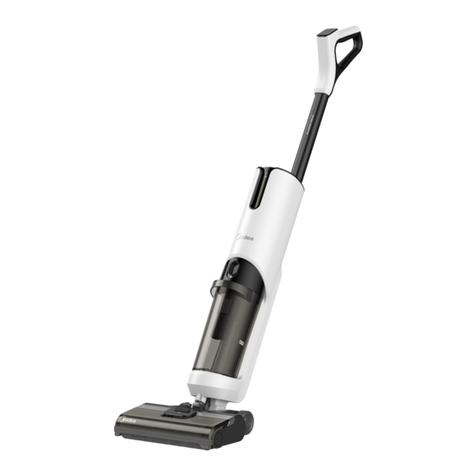
Midea
Midea MWD-40P instruction manual

Beko
Beko WMC61W Installation & operation manual

Panasonic
Panasonic NA-140VS4 Operating instructions & installation instructions
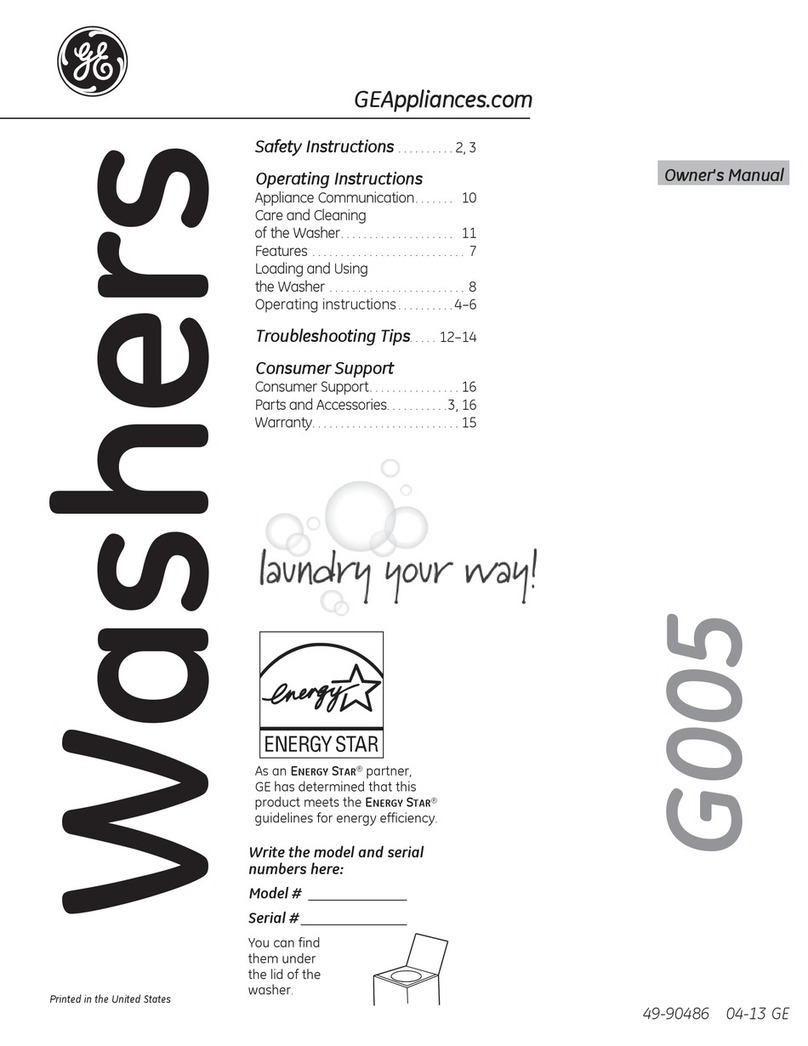
GE
GE GTWN7450DWW use and care manual
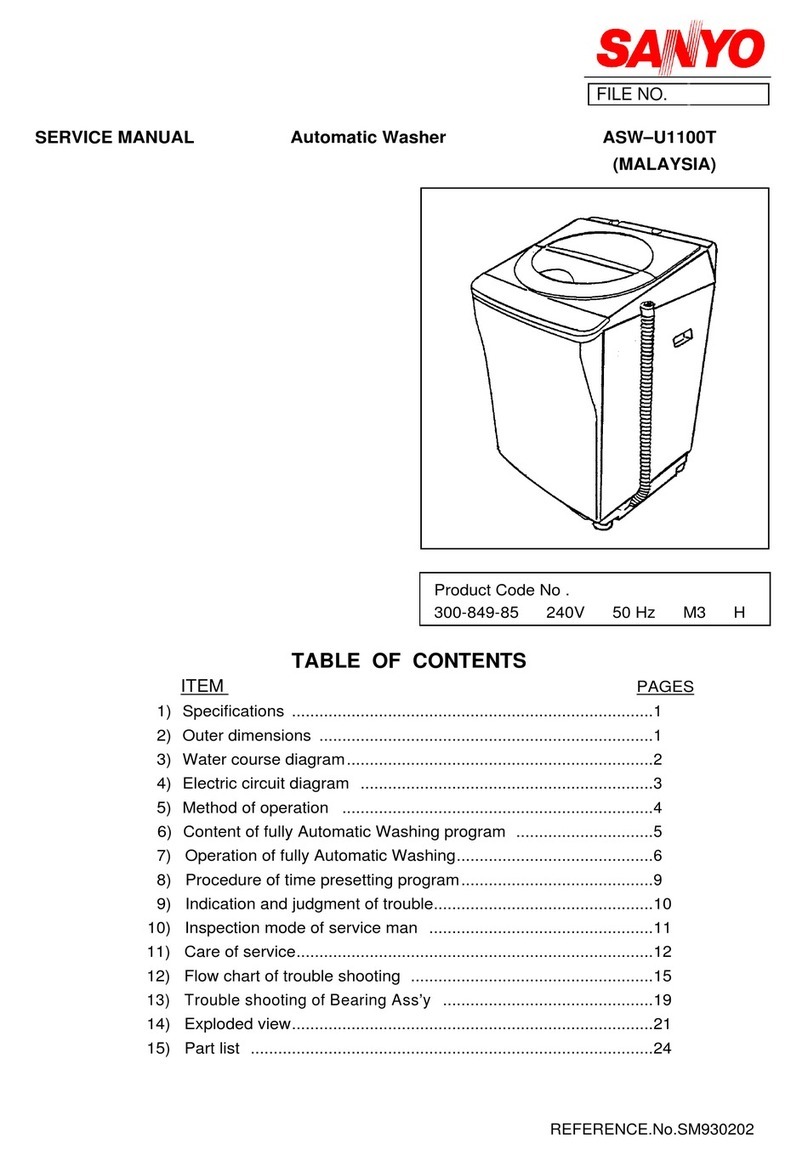
Sanyo
Sanyo ASW U1100T Service manual

